Going hiking this summer? Here's what you should wear
Stay comfortable and cool while you tackle the trails.
Products are chosen independently by our editors. Purchases made through our links may earn us a commission.
I’m going camping for the second time in my life next week and the first time in five years. Needless to say, I’m excited for my trip! But I’m also nervous about forgetting how to dress for the wild, where functionality reigns over style and comfort is essential. Camping and hiking in Florida where I live means protecting the skin against harsh sunlight, staying dry in the moist humidity, and avoiding the state's ever-persistent mosquitoes.
To ease my mind with what I should be packing, not what I want to pack, I researched the clothes and fabrics that are vital to summer hiking and camping trips. Here’s what to look for when shopping for warmer weather outdoor apparel.
Reach for these fabrics when you shop
Controlling sweat and moisture is vital for protecting against bacteria growth, which can lead to rashes, infection, and body odor. Before choosing any outdoor garment, consider the fabric that they're made from. When it comes to hiking in the heat, Merino wool is a great candidate (yes, really). Merino wool, derived from the Merino breed of sheep, is a very fine type of fabric that is much softer and less itchy than typical wool. Clothes made from Merino wool offer moisture-wicking control and temperature regulation. The National Park Service especially recommends wool for socks. Synthetic fabrics, like polyester, polypropylene, and nylon, are also great at wicking moisture away. While these synthetic fabrics are fit for quickly drying moisture, they’re also prone to bacteria growth and odor, so be wary when opting for these materials on longer hikes.
It’s also important to reach for clothing with a high UPF rating (the fabric version of the SPF you're used to seeing on sunscreens). To protect against sunlight-related conditions like premature aging, sunburn, and skin cancer, clothing with a Ultraviolet Protection Factor (UPF) rating can be even better than slathering yourself with lotions that sweat or wear off. The higher the rating of UPF, the more protection a piece of clothing can give against ultraviolet light. According to the Skin Cancer Foundation, anything with a UPF rating above 30 provides great protection, while anything above 50 is considered excellent.
Find a pair of sturdy hiking shoes
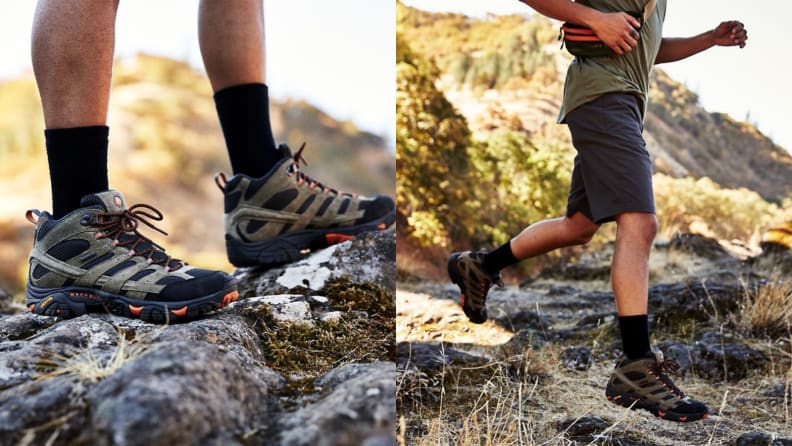
Sturdy shoes are vital for keeping balance and protecting your feet.
Durable shoes are essential for hiking, but hike-specific footwear may not be necessary. Well-trodden paths without any obstacles, such as rocks, roots, or streams, can be conquered in a regular pair of sneakers. If you have a pair with enough arch support and cushioning, and you’re OK with getting 'em a little dirty, by all means wear them on your journey.
However, longer trails, or trails with rough or steep terrain, may require a pair of hiking shoes or boots. For climbing hills or mountainous ground, you'll need ankle support to reduce the risk of injury risk or soreness. To wade through water or for wet climates, look for shoes made with Gore-Tex, a branded technology that’s water-, wind-, and weather-proof. Wet grass or loose leaves can cause a potential fall, so good traction is also a must. If bugs, branches, or even snakes are a concern on your hike, opt for mid- or high-profile boots that cover more of your ankle and leg. Otherwise, a lightweight boot or shoe that’s easy to maneuver in will work wonders on longer treks in summer weather.
Hiking sandals or water shoes are appropriate for warmer days that require less foot coverage. Sandals like Teva’s Hurricane XLT2 or Keen’s Whisper provide extra heel support on their outsoles for a breezier footwear option for all-day comfort. Both sandals are also waterproof and dry quickly. (Just don’t forget to use sunscreen on those feet!) You can find plenty of hiking sandal and boot options at retailers like DSW and Merrell.
Slip into ventilated, well-cushioned socks
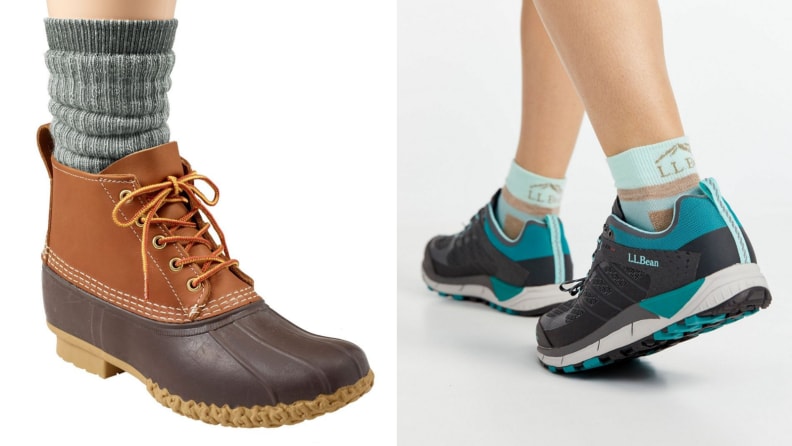
Moisture-wicking socks help quickly release sweat.
The best shoes don't mean much without a pair of hike-appropriate socks (sandals excluded, unless that's how you roll). A good hiking sock wicks moisture away from your feet for comfort and to reduce chafing, and stops odor and bacteria from building up. It can also provide extra cushioning—especially around the ball, ankle, and heel of the foot—to help prevent blisters or hot spots. For summer hikes, you may prefer to opt for lighter weight socks, though any sock labeled as medium or mid-weight will offer more padding for heavier hiking shoes and boots. Ankle and crew cut socks are best for low- to mid-cut trail shoes or boots.
One thing to note when buying hiking socks: Cotton isn’t the best choice. Cotton can’t regulate moisture well, which results in sweaty, blistering feet inside of closed-toe shoes. Merino wool's antimicrobial properties retains less odor, and the wool regulates temperature to minimize sweating. Nylon and polyester are also two fabrics that quickly dry moisture, though they aren’t as breathable as the lightweight wool. Both L.L. Bean and Merrell sell solid options for long-lasting, comfortable hiking socks.
3. Wear flexible and durable bottoms
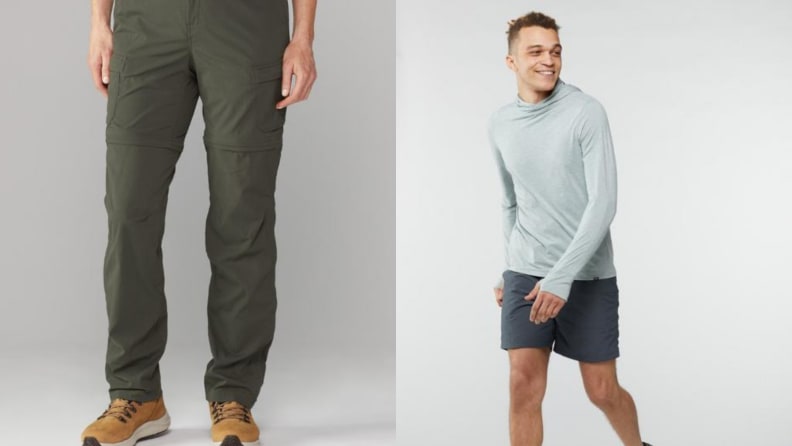
Nylon and polyester are fabrics fit for warmer weather.
It’s important to know what kind of clothing to protect your lower half based on the climate, terrain, and intensity of your hike. Warm climates call for shorts, skirts, and even athletic dresses. Look for items made with fabrics like nylon or polyester and labeled "sweat-wicking" or "moisture-wicking," which keep any wetness from being trapped against your skin. Long pants are great if you won't feel too hot, as they provide both sun protection and ward off pesky (and even dangerous) insects such as mosquitoes and ticks.
For rainy or wet terrain, nylon or polyester pants help deter moisture from the legs. If you’re looking to carry any extra items on your hike, make sure to check out pocket size, variety, and secure closures for keeping snacks and cellphones safe. Spandex and elastane fabric content in bottoms offer stretchiness and flexibility when climbing steep paths, or simply providing more room for maneuvering. I recommend shopping outdoor retailers like REI or Moosejaw for these types of pieces.
Can’t decide between shorts or pants? Convertible or zip-off pants are a great choice that requires packing one garment instead of two—a lighter load!
Find underwear that's snug and breathable
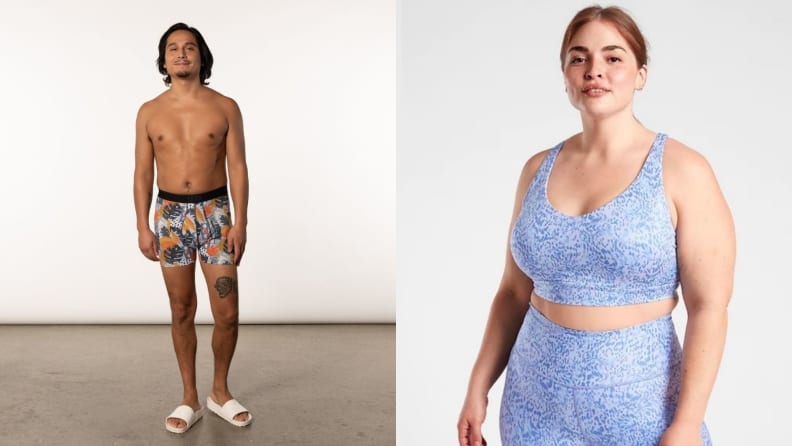
Comfortable underwear can make or break a hike.
Yes, even (and especially!) your undergarments matter when it comes to being active in the heat. When it comes to underwear, moisture-wicking fabrics are best. For sweat and moisture control, opt for quick-drying material like polyester and nylon, or modal and lyocell. Anything that retains moisture can cause odor and bacterial growth, so avoid 100% cotton, which gets soggy and stays that way. Durable, stretchy material is best for all-day comfort and no chafing. I'm a big fan of Saxx underwear for men while Reviewed's go-to apparel expert, Jamie Ueda, found Aerie underwear to be the best for women in her extensive testing.
The same goes for sports bras: Pick one that provides both proper support and ventilation from sweat. Athleta has a bunch of highly rated picks for any size chest.
Opt for moisture-wicking shirts and tees
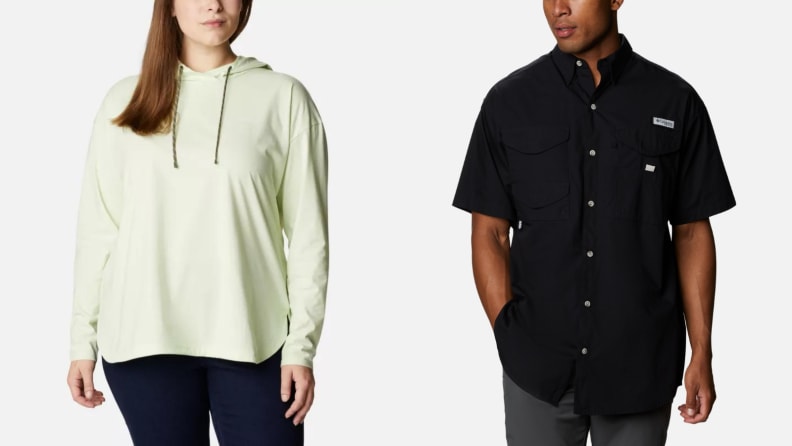
Dressing for the appropriate weather is hiking trips.
T-shirts, shirts, and tank tops are all solid base or main layers for hiking. For simple basics, high-quality merino wool is best for combatting perspiration and feeling cool. Otherwise, any top made with a blend of polyester and nylon can help wick moisture on a hike. This is important when carrying a backpack or wearing an additional layer, which can create more sweat and odor. Reach for labels that state clothing is “breathable” in hot climates and feature a high UPF. Both my girlfriend and I are big fans of Columbia shirts for all of our outdoorsy activities.
Outdoor outerwear is sometimes made with rip-stop material, meaning it’s extra durable and tough to rip or tear. This is especially useful with any jackets that might snag on tree branches.
Finish off with accessories that guard against the sun
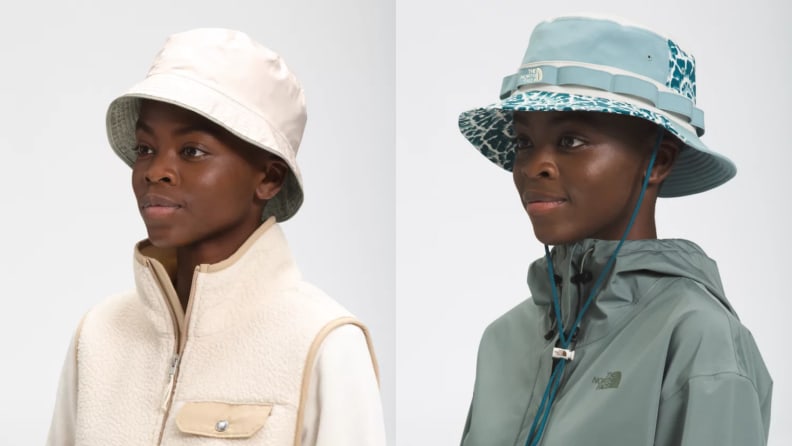
Bucket hats offer protection from the harsh sunlight.
Accessories like hats, gloves, or sunglasses are optional but they can elevate your hiking experience. Hats with a 360-degree brim—like bucket hats—will block harsh sunlight from your eyes, face, and neck. Baseball caps are fine for the face but provide less all-around coverage. For headwear specifically designed for the outdoors, L.L. Bean sells hats with built-in insect repellant, while Columbia has hats with a UPF of 50+.
Sunglasses offer a layer of protection for the eyes against the sun’s rays. While sunglass style depends on personal preference, polarized lenses protect against intense UV rays and reduce glare. Lenses made with polycarbonate are also more shatter-resistant—a must if you're scampering over rocks or prone to dropping your shades. You can find a wide variety of both types of sunglasses at REI.
